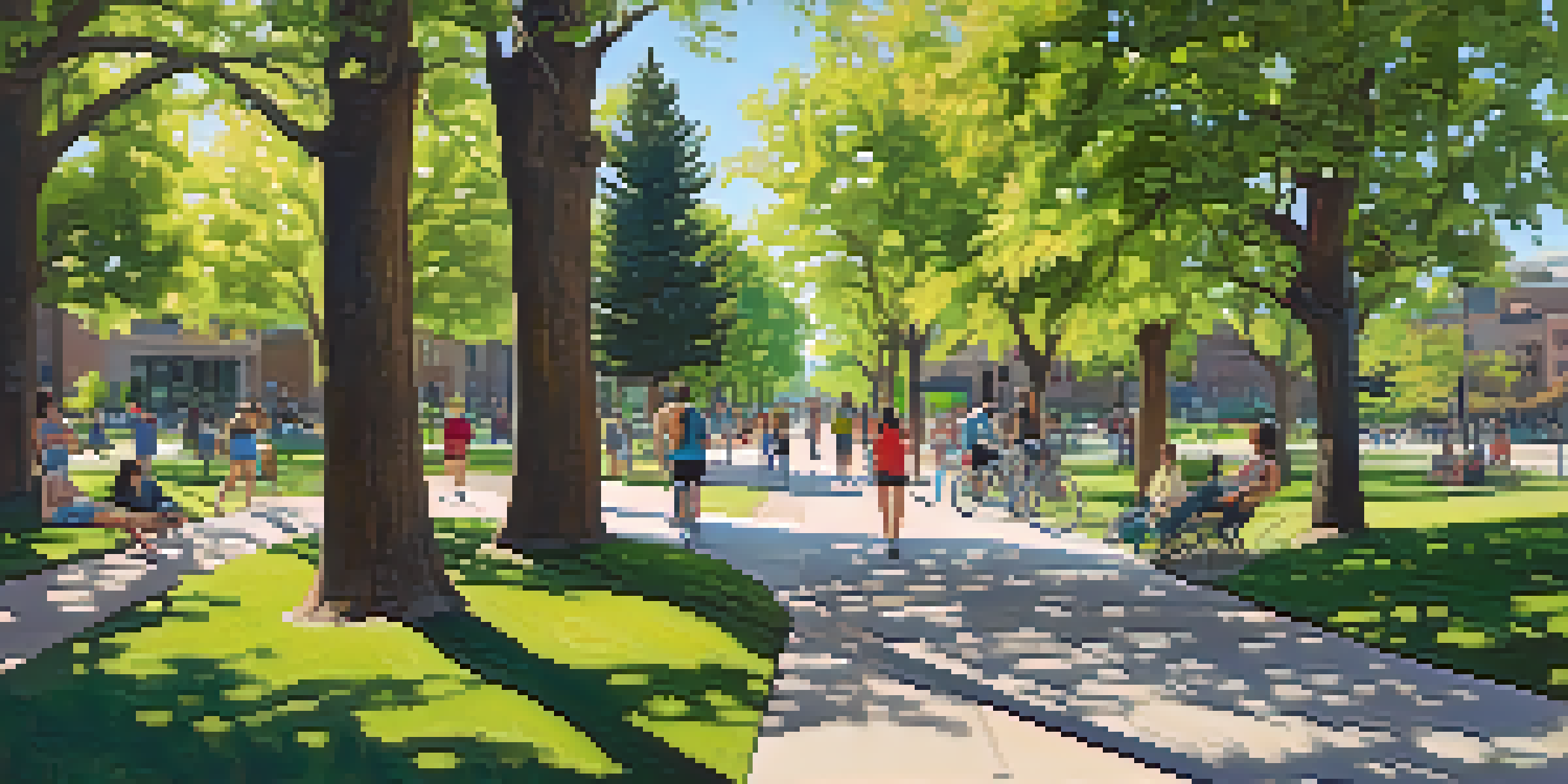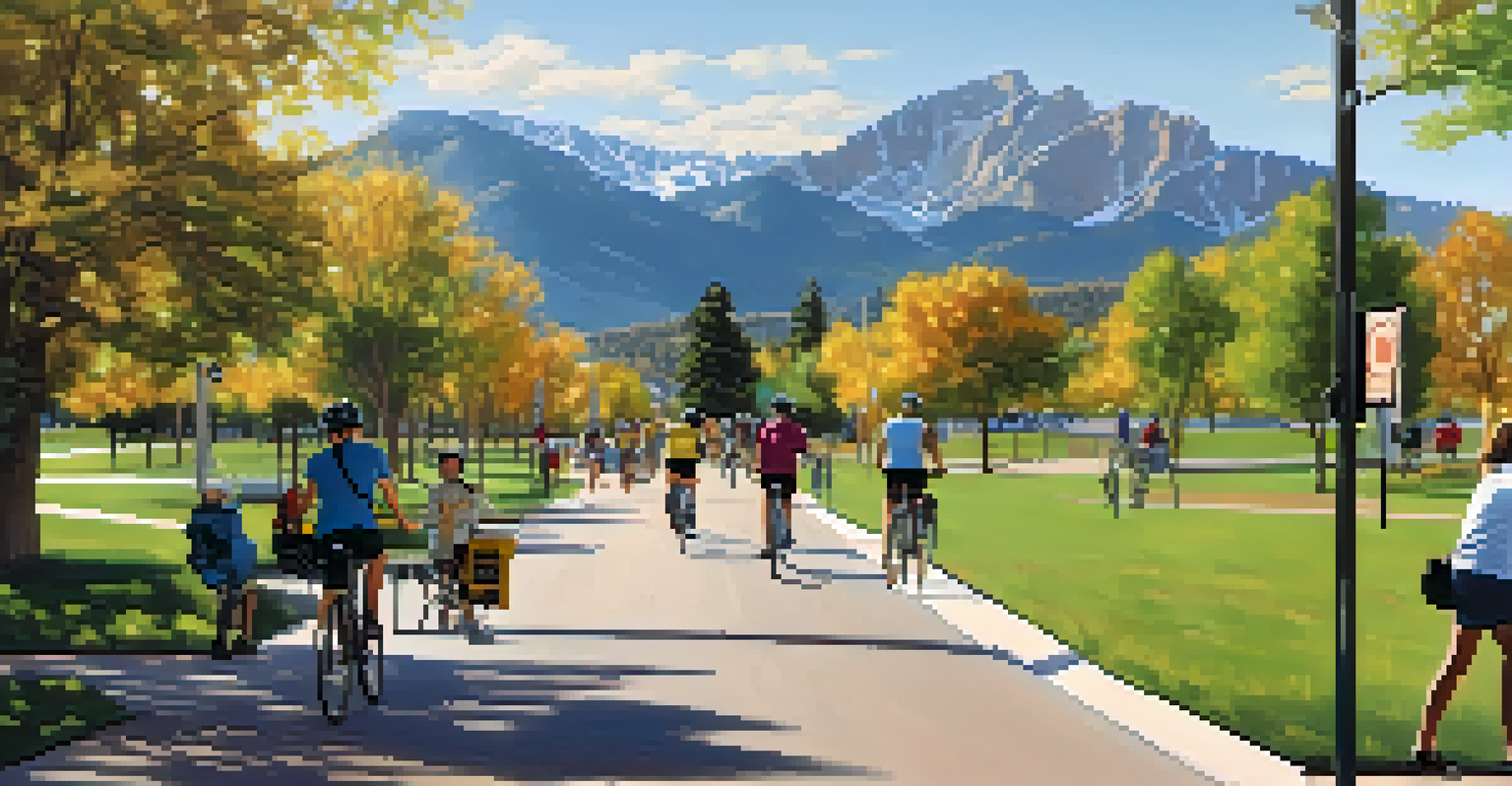Urban Planning: Boulder's Strategies Against Heat Islands

Understanding Urban Heat Islands and Their Impact
Urban heat islands (UHIs) are areas in cities that become significantly warmer than their rural surroundings due to human activities. This phenomenon can lead to increased energy consumption, elevated emissions of air pollutants, and exacerbated heat-related illnesses. In Boulder, the effects of UHIs are felt particularly during the summer months when temperatures can soar, making it essential for the city to address this issue.
The city that is the most successful in dealing with climate issues is the one that understands the importance of involving and engaging its community.
The impact of UHIs extends beyond discomfort; they contribute to environmental degradation and increased costs for cooling systems. In a city like Boulder, known for its outdoor lifestyle, the consequences of rising temperatures can deter residents from enjoying parks and recreational spaces. Understanding these implications is the first step towards effective urban planning strategies.
Fortunately, cities can implement several strategies to combat UHI effects, from increasing green spaces to adopting reflective building materials. By recognizing the problem, Boulder is taking a proactive approach to ensure its urban environment remains healthy and livable for all its inhabitants.
Boulder's Green Infrastructure Initiatives
One of the primary strategies Boulder employs to combat the heat island effect is the enhancement of green infrastructure. This includes planting more trees, creating green roofs, and expanding parks. These green spaces not only provide shade but also help cool the air through a process known as evapotranspiration, where plants release moisture into the atmosphere.

The city has committed to increasing its tree canopy cover as part of its urban planning efforts. Trees play a crucial role in reducing surface temperatures, improving air quality, and providing habitats for wildlife. Boulder's initiative to plant more trees reflects its dedication to maintaining a sustainable and resilient urban ecosystem.
Boulder's Green Infrastructure Efforts
Boulder is enhancing its green infrastructure through tree planting and park expansion to combat urban heat islands and improve community well-being.
Additionally, Boulder's parks and natural areas serve as vital community spaces that encourage outdoor activities, further promoting a healthy lifestyle. By investing in green infrastructure, Boulder is not only addressing the UHI effect but also enhancing the quality of life for its residents.
Implementing Cool Roof Technologies
Cool roofs are another innovative strategy Boulder is exploring to mitigate the heat island effect. These roofs are designed to reflect more sunlight and absorb less heat than traditional roofing materials. By using reflective coatings or specially designed materials, buildings can maintain cooler indoor temperatures, reducing the need for air conditioning.
Green infrastructure is not just about aesthetics; it’s about creating a sustainable urban environment that benefits everyone.
In Boulder, several public and commercial buildings have already adopted cool roof technologies, demonstrating the city’s commitment to sustainable practices. This shift not only helps lower energy costs but also contributes to the overall reduction of urban temperatures. The positive impact of cool roofs can be felt in both the immediate environment and the broader community.
Boulder's embrace of cool roofing systems serves as an excellent example of how cities can leverage technology to combat climate challenges. As more buildings adopt these practices, the cumulative effect can significantly diminish the heat island impact across the city.
Promoting Sustainable Transportation Options
Boulder recognizes that transportation plays a crucial role in urban heat dynamics. As more people rely on cars, the resulting emissions and heat generation contribute to UHI effects. To address this, Boulder is promoting sustainable transportation options such as biking, walking, and using public transit.
The city has developed extensive bike paths and pedestrian-friendly infrastructure, making it easier for residents to choose non-motorized transportation. By reducing the number of vehicles on the road, Boulder not only helps mitigate heat islands but also promotes healthier lifestyles and reduces air pollution.
Adoption of Cool Roof Technologies
The city is implementing cool roof technologies in public and commercial buildings to reflect sunlight and reduce indoor temperatures.
Boulder's commitment to sustainable transportation reflects a broader understanding of the interconnectedness of urban planning and environmental sustainability. By investing in alternatives to driving, the city is fostering a more resilient and enjoyable urban environment.
Community Engagement in Urban Planning
Effective urban planning requires the involvement and input of the community. Boulder has made it a priority to engage residents in discussions about strategies to combat heat islands. Through public forums, surveys, and workshops, residents are encouraged to share their insights and suggestions.
This community engagement not only empowers residents but also ensures that the strategies implemented meet the needs of those most affected. By fostering a sense of ownership in urban planning initiatives, Boulder cultivates a collaborative spirit that can lead to more successful outcomes in combating UHIs.
Moreover, when residents are informed and involved, they are more likely to support and participate in sustainable practices. This collective effort strengthens Boulder's resilience against the heat island effect and enhances the overall well-being of the community.
Leveraging Technology for Urban Monitoring
To effectively address urban heat islands, Boulder is leveraging technology for better monitoring and data collection. By utilizing sensors and satellite imaging, the city can track temperature variations and identify the most affected areas. This data-driven approach allows for more informed decision-making in urban planning.
Having access to real-time data enables Boulder to evaluate the effectiveness of its strategies in combating UHIs. For instance, the city can assess the impact of newly planted trees or the implementation of cool roofs and make necessary adjustments to its plans. This continuous feedback loop is vital for long-term success.
Community Engagement in Planning
Boulder prioritizes community involvement in urban planning to ensure strategies effectively address the needs of those affected by heat islands.
Technology not only aids in monitoring but also in engaging the community. Residents can access information about temperature variations and participate in initiatives to cool their neighborhoods. By embracing technology, Boulder is enhancing its ability to combat the heat island effect effectively.
Future Directions for Boulder's Urban Planning
Looking ahead, Boulder aims to expand its efforts to combat urban heat islands through innovative urban planning. This includes integrating climate resilience into new developments and retrofitting existing infrastructure. The city is exploring additional strategies such as rain gardens and permeable pavements to further enhance its green infrastructure.
Boulder also plans to continue fostering community involvement, ensuring that residents remain engaged and informed about urban planning decisions. By working together, the city can adapt to changing climate conditions and develop solutions that address the needs of its diverse population.

Ultimately, Boulder's commitment to sustainable urban planning and its proactive strategies against heat islands position it as a model for other cities facing similar challenges. By prioritizing both environmental and community health, Boulder is paving the way for a cooler, more resilient urban future.